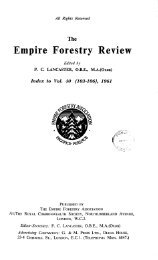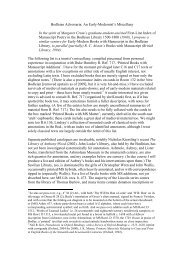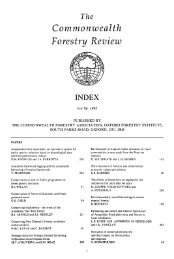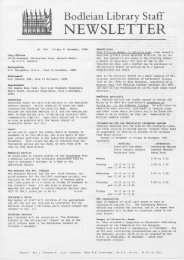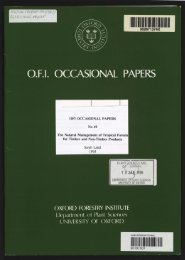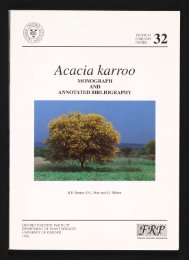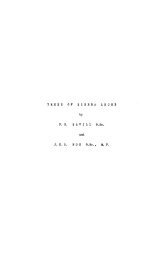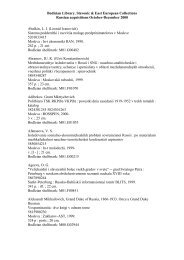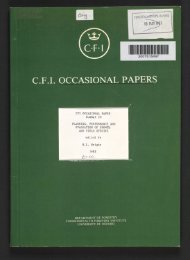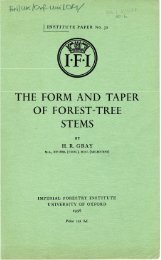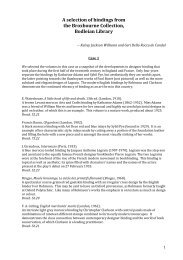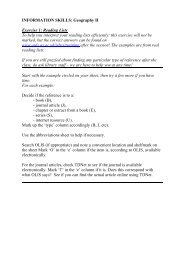Commonwealth Forestry Review
Commonwealth Forestry Review
Commonwealth Forestry Review
You also want an ePaper? Increase the reach of your titles
YUMPU automatically turns print PDFs into web optimized ePapers that Google loves.
RESEARCH NOTES<br />
5. GRACE, N. H. 1939. Vegetative propagation of conifers. I. Rooting of cuttings taken<br />
from the upper and lower regions of a Norway spruce tree. Can. J. Res. 17 (Sect. C):<br />
178-180.<br />
6. GRACE, N. H. and M. W. THISTLE. 1940. Vegetative propagation of conifers. V. The<br />
effect of indolylacetic acid and nutrient solutions on the rooting of Norway spruce<br />
cuttings. Can. J. Res. 18 (Sect. C): 122-128.<br />
7. KRUSSMANN, G. 1966. La pepiniere. Vol. I. La multiplication des arbres, arbustes et<br />
conifers. La Maison Rustique, Paris. p. 327.<br />
8. LARSEN, C. M. 1946. Experiments with softwood cuttings of forest trees. Forstl.<br />
F orsogsv. Danmark. 17: 289-443.<br />
9. LARSEN, C. M. 1955. The seasonal variation in the natural rooting capacity of<br />
cuttings of Norway spruce and Sitka spruce. Z. Forstg. Forstpflanzenzuchtung 4:<br />
69-80.<br />
ID. OLIVER, R. W. and S. H. NELSON. 1958. Propagation of spruce from cuttings. Proc.<br />
Plant Prop. Soc. 7: 41-43.<br />
11. PEDERSEN, J. 1965. Propagation from cuttings of Picea pungens "Glauca Globosa."<br />
Proc. lilt. Plant Prop. Soc. 15: 207.<br />
12. SAVELLA, L. 1965. Propagation of Picea pungens glauca cultivars. Proc. Int. Plant<br />
Prop. Soc. 15: 199-202.<br />
13. \VELLS, J. S. 1953. Pointers on propagation; propagating Koster Spruce. Amer Nurs.<br />
98 (9): 13, 48-53.<br />
NIGERIA<br />
Fertiliser Response of Eucalyptus grandis A. L. Mc.Comb, G.C.A. Ojo and J. K.<br />
Jackson.<br />
IN 1966 an inspection of two-year-old plantations of Eucalyptus grandis on the<br />
MambiIla Plateau, North East State showed that most of the trees at both<br />
Maisamari and Nguroje were slow growing and had reddish-purple leaves. Trees<br />
with normal green leaves were two to three times taller. Young maize plants in<br />
adjacent fields showed classical symp'to·ms of p,hosphorous deficiency. Quick tests<br />
made on the soil with Hellige-Truog equipment gave pH values ranging from 5.2<br />
to 5.8 and showed phosphorus, calcium and magnesium to· be very low.<br />
The following experiment was conducted to ascertain if E. grandis seedlings on<br />
one of the soils were suffering from phosphorus deficiency, to determine if other<br />
nutrients might be limiting growth and to see if calcium and magnesium would<br />
improve growth, possibly by increasing availability of phosphorus.<br />
Methods<br />
Two bags of soil were o,btained from the Maisamari plantation through the local<br />
forestry officer. One represented the top soil from 0-6 in. (0-0.15 m.), the second,<br />
subsoil from 12-18 in. (0.30 to 0.46 m). Thirteen nutrient treatments with a control<br />
were applied to each soil in standard (3 x 9 in.) black polythene p,ots. There was<br />
sufficient soil for only seven replicates of the surface so,il and five of the subsoil.<br />
Seeds of E. grandis were sown in each pot and the seedlings later thinned to one<br />
per pot. except for some subsoil pots 'where seedlings grew very poorly. During<br />
germination the pots were watered several times a day by means of a spray to keep<br />
the top 2 in. of soil constantly moist. Sample pots were weighed periodically to<br />
determine the amount of water to be added. The quantity added twice daily was<br />
approximately equal to evapotranspiration losses and it brought the soil to near the<br />
field capacity.<br />
Soil analyses<br />
Standard laboratory chemical and particle size analyses were made on samples<br />
from each lot of soil. pH was determined with a glass electrode in a 1-2.5 soil<br />
\vater mixture, organic matter by oxidation with chromic acid and phosphorus<br />
31



